The Old West is something uniquely and iconically American and it’s become an essential part of the American mythos.
Gun owners especially seem to feel a connection to this particular era of American history, presumably due to the important role that firearms played.
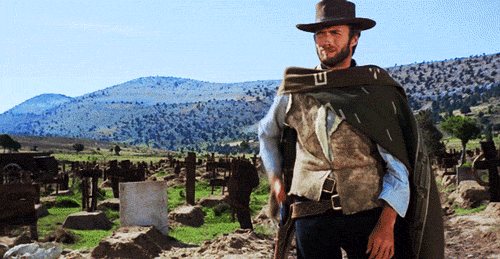
Just look at cowboy action shooting for one example of this enthusiasm.
Today we’re going to celebrate a few of the Old West’s most iconic shooters, including both gunslingers and trick shooters.
We’ll talk a bit about each shooter’s life and what made them famous as well as a couple of their favorite firearms.
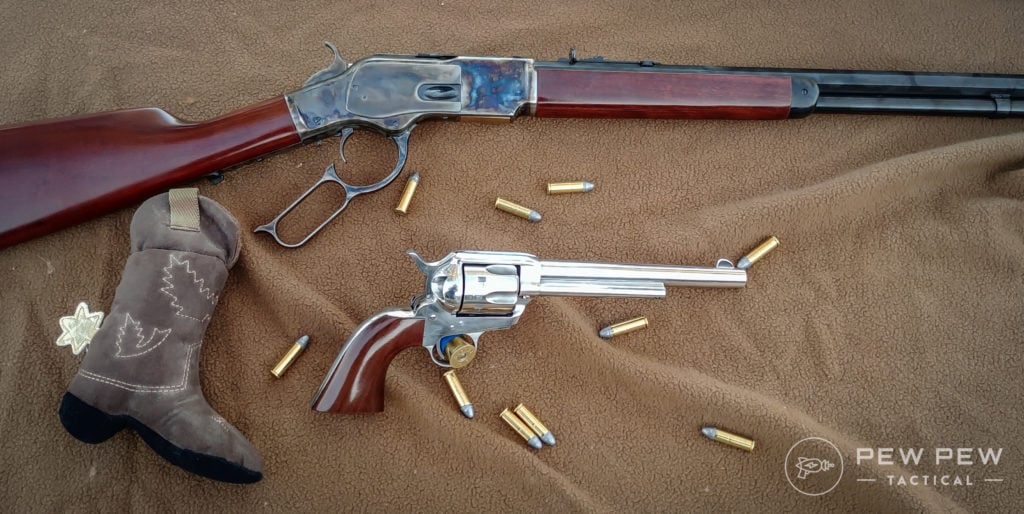
Let’s get started.
Table of Contents
Loading…
1. Doc Holliday
Doc Holliday was one of the West’s most famous gunslingers, but his past may surprise you.
He was born John Henry Holliday in 1851 in Griffin, Georgia, a town about 35 miles south of Atlanta. He was raised as a southern gentleman and was well educated, earning his Doctor in Dental Surgery at just 20 years old.
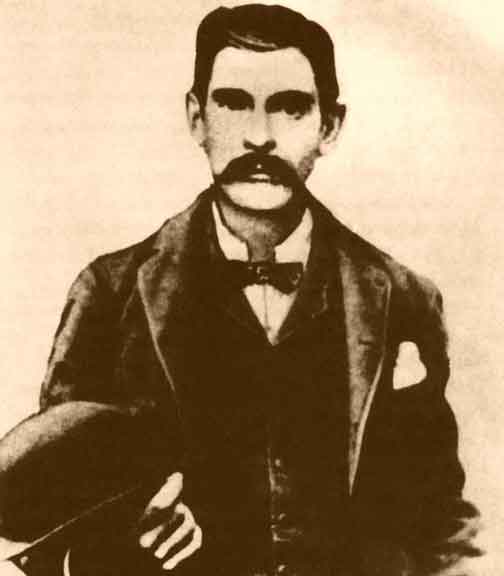
So how did he go from a gentleman dentist in Georgia to becoming a Western gambler and gunslinger?
In a word, tuberculosis.
In 1873, shortly after he began practicing dentistry, Doc was diagnosed with the disease. He was given only a few months to live, but the doctor suggested that a warm, dry climate might help.
So Doc boarded a train to Dallas, Texas, where he quickly began a life of gambling, drinking, gunfighting, and even a little dentistry.
His increasingly deteriorating health made the dentistry part increasingly difficult and before long, Doc’s primary source of income was gambling.
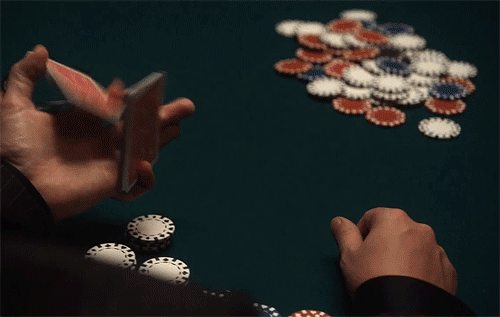
After a couple of years in Dallas, Doc left the state following some legal troubles and began to wander the West for a while.
During a stint in Dodge City in 1978, Doc met and befriended Wyatt Earp after the dentist saved the lawman’s life, though the exact details of what happened are debated.
Doc eventually joined Wyatt, along with his brothers, in Tombstone, Arizona in 1880. There Doc would continue his friendship with the Earps and, in 1881, help them in the Gunfight at the O.K. Corral.
Which brings us to Holliday’s guns.
The only gun that we know for sure that Holliday owned was a Colt 1851 Navy Revolver, a cap-and-ball revolver with a 7.5-inch barrel, that was given to him by his uncle after the Civil War.
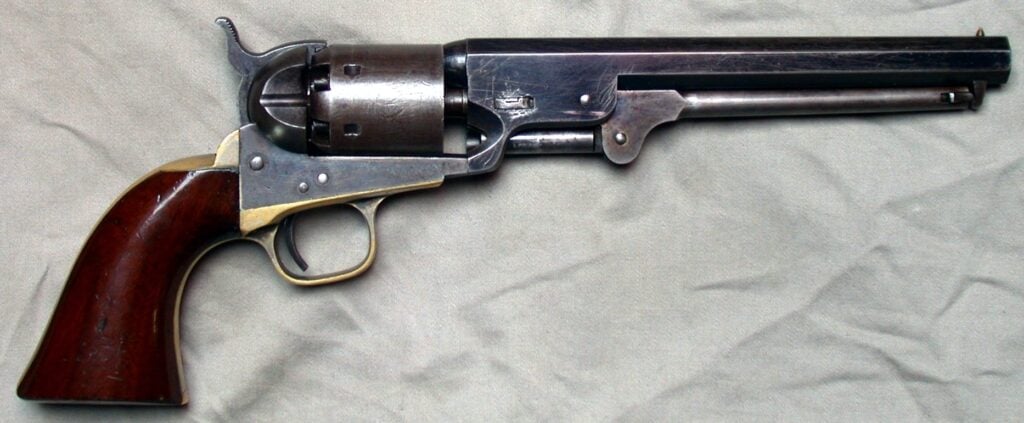
Doc held onto that revolver, and its original holster, for the rest of his life, and after his death in 1887, it was kept in the family’s possession until it was sold in the 20th century.
Other references from sources throughout Doc’s life have led historians to believe that Doc also owned a pearl-handled, nickel-plated Colt M1877 Lightning.
This short-barreled, single-action revolver was chambered for .38 caliber and is the gun that Holliday is believed to have used during the shootout at the O.K. corral.
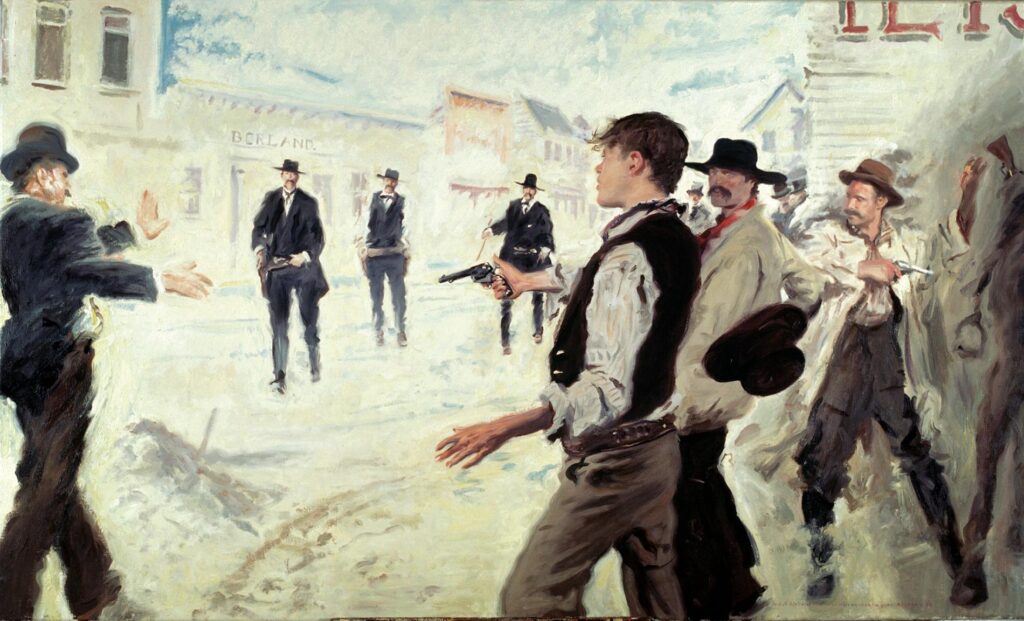
Unlike the Navy Colt, however, we can’t identify a particular revolver that would have belonged to Doc.
No such revolver was found in Doc’s possessions after he died, but it’s possible that he sold it, along with other firearms, towards the end of his life as his illness got worse and it became more difficult for him to earn money in other ways.
As for Doc’s close friend, Wyatt Earp, there’s even more ambiguity. All that’s known is that the lawman carried a single-action revolver, possibly a Colt or Smith & Wesson.
2. Annie Oakley
While not technically a gunslinger, Annie Oakley is probably even more famous for shooting than Doc. She was not even really Western.
Still, her performance with Buffalo Bill’s Wild West show cemented her connection with the Western frontier in American culture, so I decided to include her anyway. In reality, when Annie wasn’t traveling with the show, she spent the bulk of her life in Ohio.
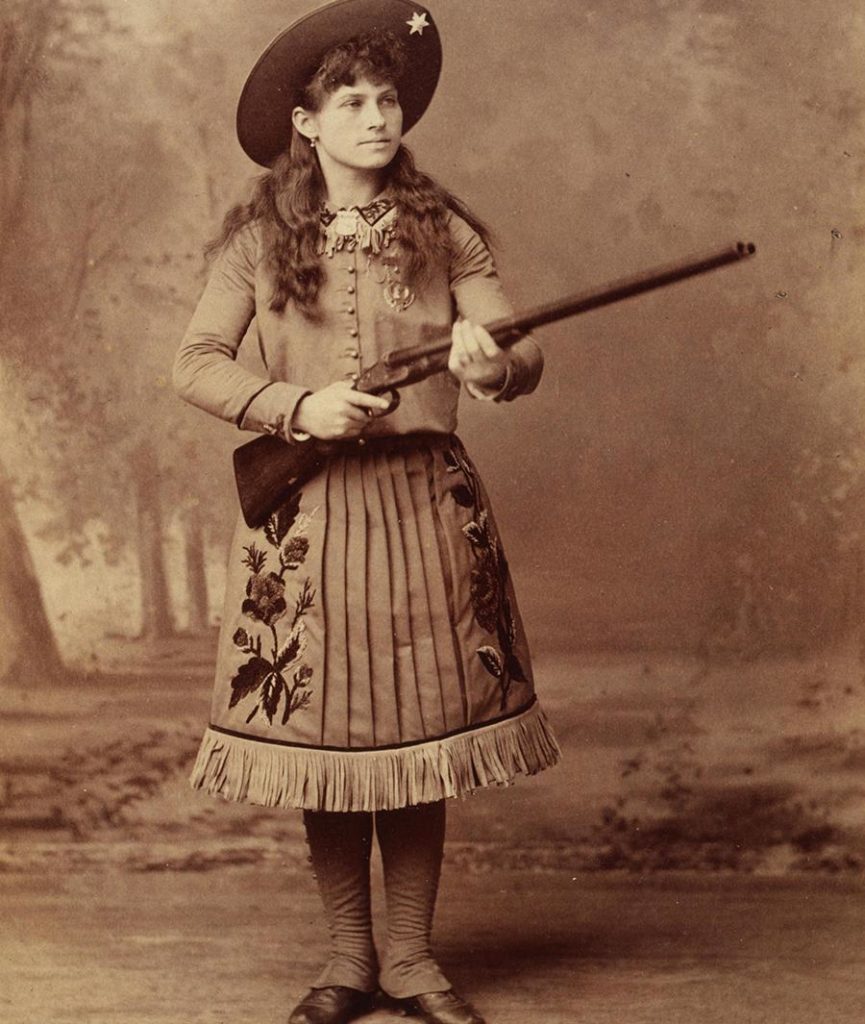
Annie was born Phoebe Ann Mosey in 1860 in rural eastern Ohio. She would only take on the name Annie Oakley as a stage name after she started performing.
Oakley had a rough childhood, marked by poverty, and began trapping and hunting early as a way to support her family. She sold the game to residents of a nearby city, as well as to restaurants and hotels.
Her skill allowed her to help pay off the mortgage on her mother’s farm when she was just 15 years old (Annie’s father died when she was 5).
It also earned her a reputation in the region. When traveling marksman Frank E. Butler came to Cincinnati, he placed a bet with a local hotel owner that Butler could beat any local shooter.
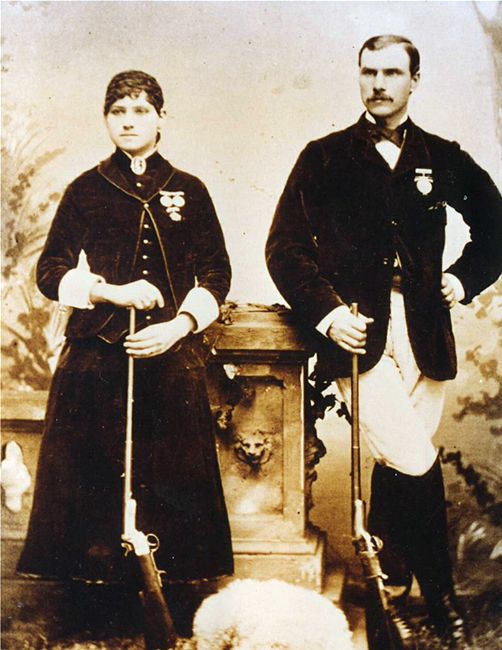
The hotel owner arranged for him to compete with Annie and Butler lost to the 5-foot tall young woman.
He was taken with her and immediately began courting her. The couple married a year later and began performing together. In 1885, they joined Buffalo Bill’s Wild West.
The fame that Annie developed over her 16 years performing with the show has fortunately made it easy for history to keep track of the many, many guns that she owned.
In 1887, British gun maker Charles Lancaster reached out to Oakley. He’d seen her perform multiple times and realized that the size of her guns didn’t suit her petite frame, preventing her from performing at her true potential.
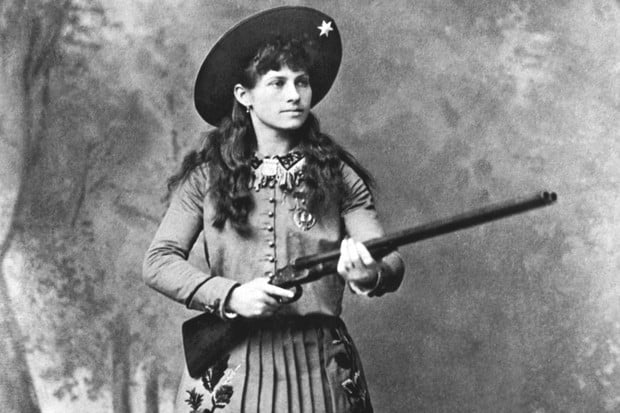
In response, he built her a few custom shotguns built to be more lightweight and fit the measurements of Annie’s shoulders and arms. From that point on, Annie had all of her rifles and shotguns made to the same measurements that Lancaster used.
One of those shotguns is currently on display in the National Annie Oakley Center at the Garst Museum in Greenville, Ohio.
Also on display at the Garst Museum is Annie’s Winchester 1873. This rifle was manufactured in 1892 and was given to her by Buffalo Bill.

Like the other rifles used by Annie and Buffalo Bill to shoot aerial targets, it’s a smooth-bore rifle and was used to shoot a .44-40 cartridge that contained a quarter ounce of #7 chilled shot.
The use of shot wasn’t to help accuracy; the pattern was only about 1.5 inches wide at 30 yards.
It was actually a safety precaution the Buffalo Bill and his partner enacted after an 1883 performance in Brooklyn where they broke windows in a greenhouse a block and half away.
The use of standard ammunition for these kinds of performances was a real risk to not just the audience, but also people and property in the area surrounding the show.
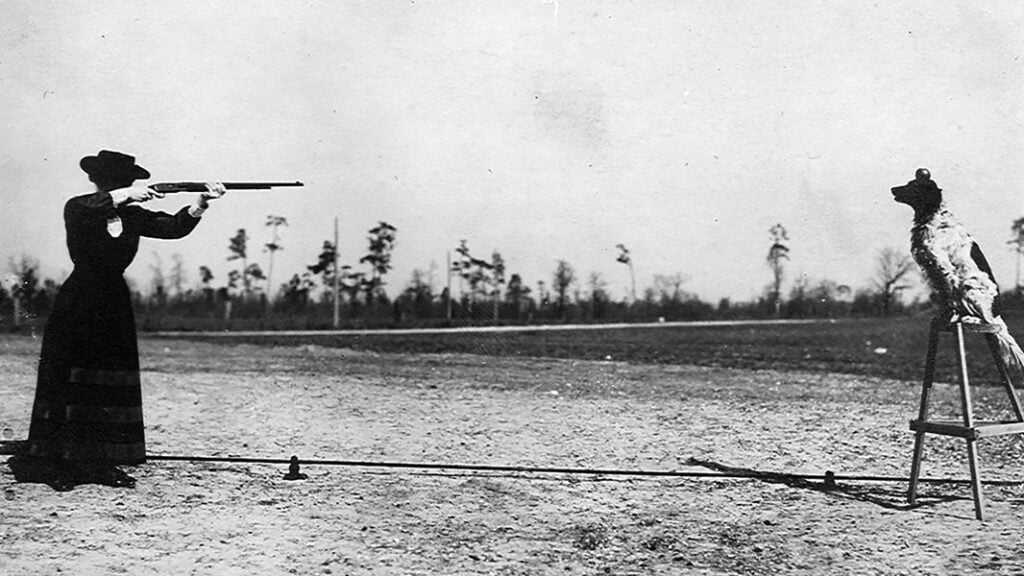
More of Oakley’s guns can be viewed at the Buffalo Bill Center of the West in Cody, Wyoming. One of these is her .44 caliber Smith & Wesson No. 3 revolver, one of three that she ordered throughout her lifetime.
Another is her Winchester Model 1892, a .44-40 caliber rifle with a half round/half octagon smoothbore barrel. Like her other long guns purchased after 1887, the rifle was custom made for her.
It had a shotgun butt plate for comfort and a hand-checkered walnut stock.
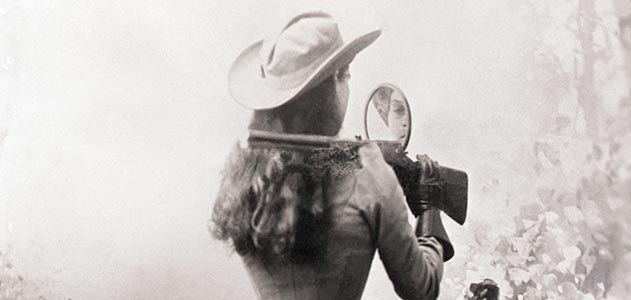
If you want to learn more about Oakley’s life, you can check out her entry on my list of badass lady shooters.
3. Buffalo Bill Cody
Of course, we can’t talk about Annie Oakley without also talking about Buffalo Bill. While Oakley’s association with the West was basically just branding, Buffalo Bill was the real deal.
He was born in 1846 in the Iowa Territory.
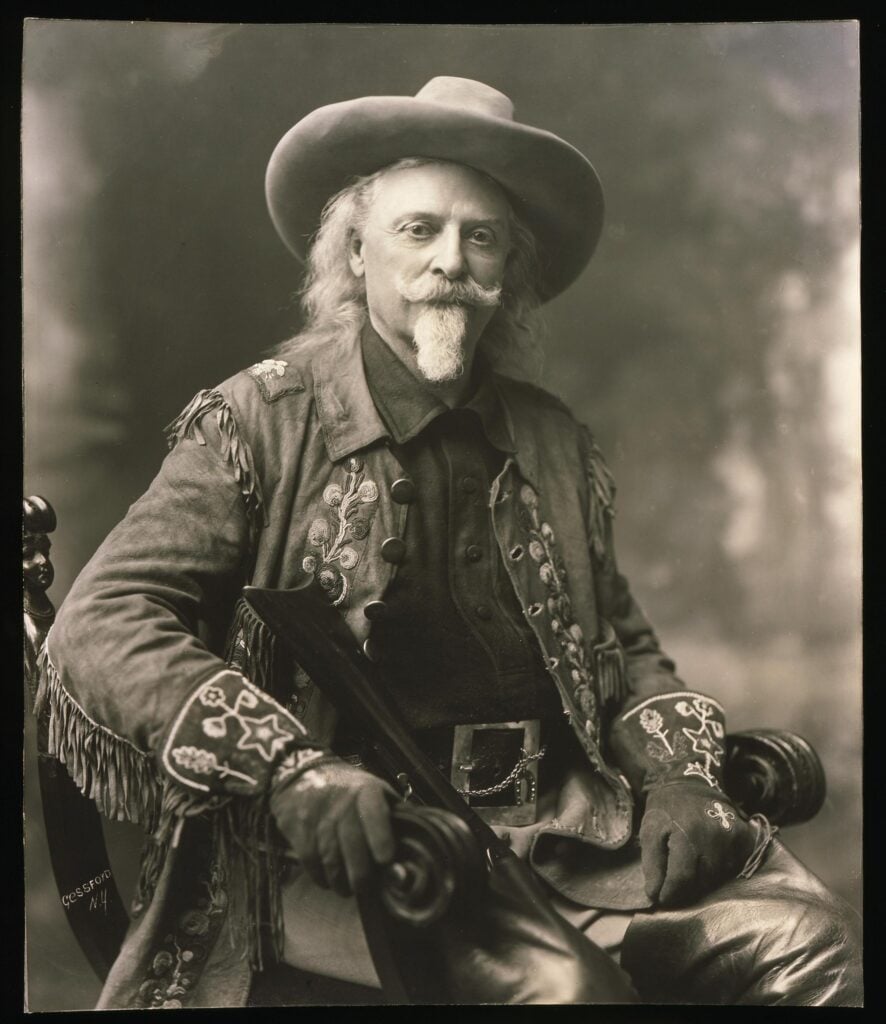
The next year, his father moved the family to his own hometown in Ontario for several years, before ultimately selling the land in Iowa and moving the family farther west to the Kansas Territory in 1853.
In 1857, however, Bill’s father died. In a story similar to Annie Oakleys, the death led the family to face financial troubles and Bill took on responsibility for supporting them despite being just 11 years old.
He took on various jobs over the next few years including, riding a horse up and down a wagon train delivering messages for a freight company, a scout for the US Army during the clash between Mormon settlers and the US government in the Utah Territory, and a rider for the Pony Express.
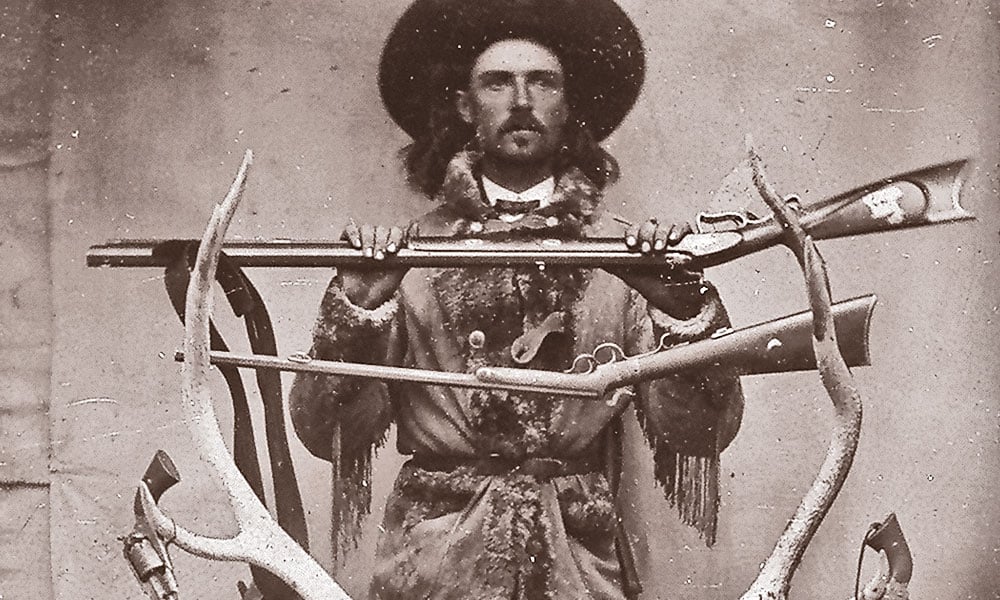
Cody was employed by the Army as a scout again in 1866 during the Plains Wars.
In 1869, Cody met the journalist Ned Buntline who created a largely fictionalized version of Cody’s real experiences, taking advantage of America’s fascination with the Western frontier and turning Buffalo Bill into a legend.
Buntline and other writers would go on to write various sequels for decades after.
In 1872, Buffalo Bill began performing in various Wild West shows but he didn’t start Buffalo Bill’s Wild West until 1883.
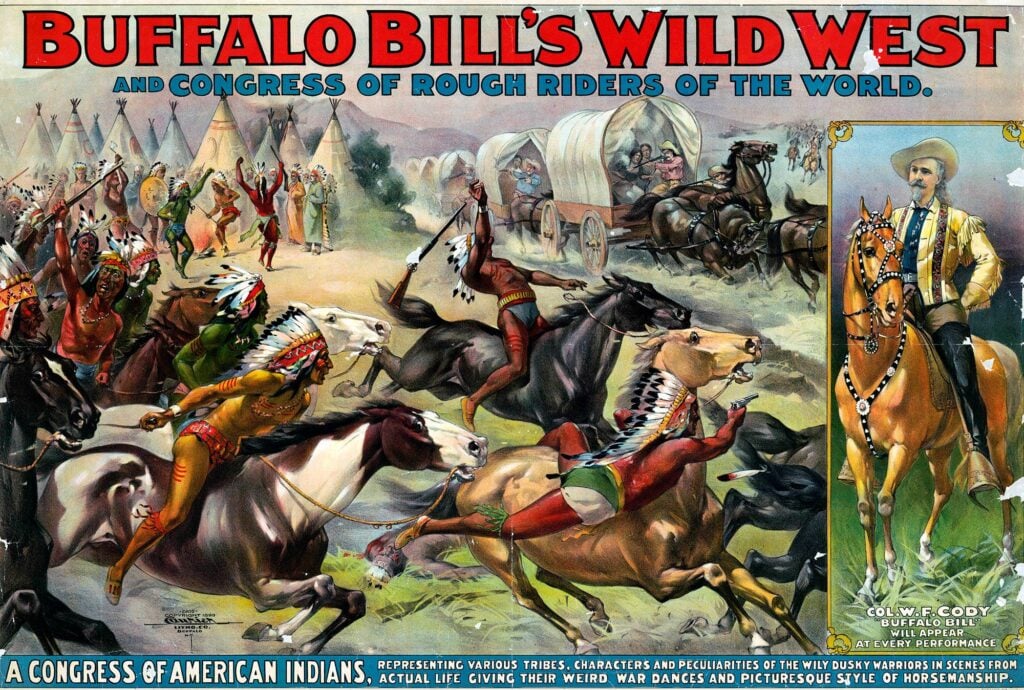
The show lasted for almost 20 years, achieving great fame in both the US and Europe, and was performed in front of numerous important people, including Queen Victoria and Pope Leo XIII.
Some historians believe that around the turn of the century, Cody might have been the best-known celebrity on the planet.
Like Annie, Buffalo Bill had numerous firearms that he used throughout his life.
One is a .45-70 Remington Rolling Block rifle that may have been given to him by the Remington family.
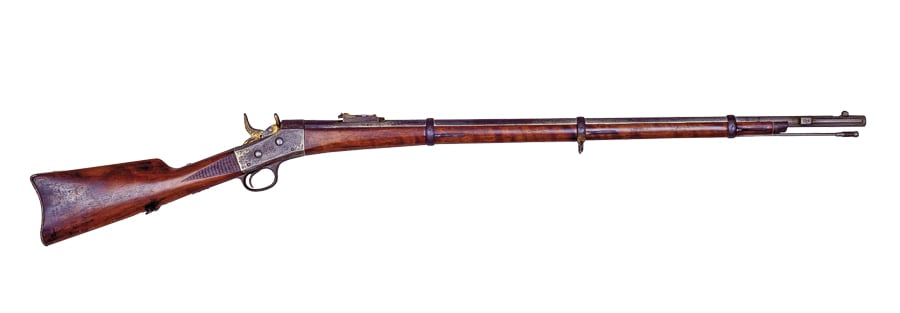
Though the Remington Rolling Block was a military-style rifle, this one’s serial number of 3, gold plated hammer, and engraved block all show that it wasn’t just a run of the mill production.
It’s not clear exactly when Bill acquired this rifle, but there’s a photo of him holding it that was taken in the 1870s and he gave it to his friend Moses Kerngood in 1875.
Just like Annie, Bill also had a smooth bore Winchester 1873 in .44-40 that he used while performing. While Annie preferred a simple but high-quality firearm, Bill’s tastes leaned towards the more ostentatious.
His 1873 featured an engraved gold-plated receiver with a buffalo and scrollwork on the left side and a depiction of Cody on horseback pursuing a buffalo on the right side.
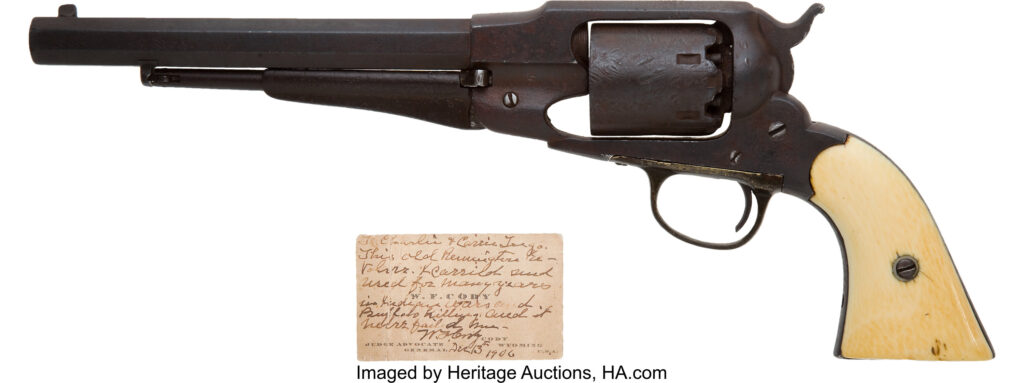
And we also have to talk about Cody’s Springfield Model 1866 Trapdoor Rifle. This is the rifle that turned William Frederick Cody into Buffalo Bill.
Cody used this rifle in 1867 and 1878 while working for Kansas Pacific Railroad as a buffalo hunter to provide railroad construction workers with meat. He also used in competition against Billy Comstock for the title of World Championship Buffalo Hunter.
Cody named the rifle Lucretia Borgia because he considered the rifle, like the renaissance-era duchess, both beautiful and deadly.
4. Billy the Kid
Of course, we can’t have a list of famous Western shooters and not include at least one outlaw, so next up is Billy the Kid.
He was born Henry McCarty in 1859 in New York City. The Billy the Kid nickname comes from his alias William H. Bonney, his boyish attitude, and the fact that he gained his criminal notoriety early before dying at just 21 years old.
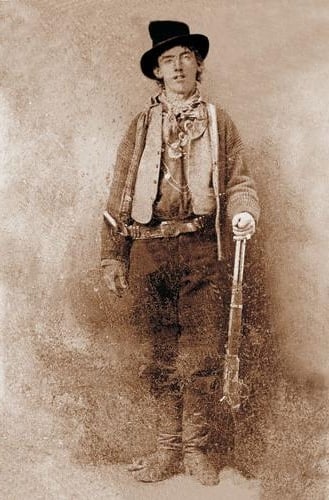
Like our last two famous shooters, Billy lost his father when he was still a child. Though her mother remarried, the man, William Antrim, abandoned the family in 1874, shortly before Billy’s mother died of tuberculosis, leaving him an orphan at 15 years old.
At this point, the family was living in Silver City, New Mexico. The owner of a local boarding house provided Billy with room and board in exchange for work, but Billy still turned to criminal pursuits.
He was first caught stealing food, then he robbed a Chinese laundry 10 days later. Following the second incident, Billy was arrested but escaped two days later. He later moved to the Arizona Territory.
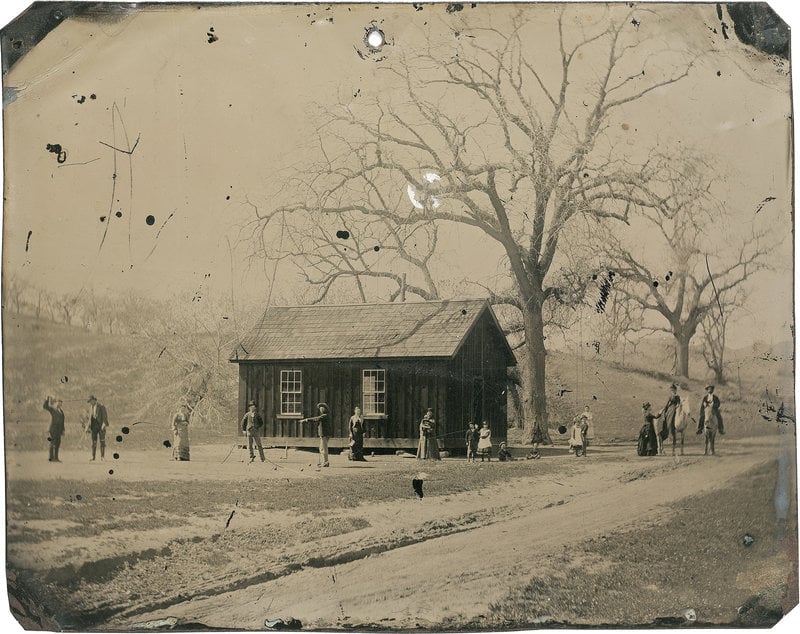
There he began working as a ranch hand and met John R. Mackie, with whom he started stealing horses from the soldiers stationed at the nearby US Army Post, Camp Grant.
In 1877, Billy would be responsible for the death of his first man, after shooting a man in a saloon after a verbal argument led to both men fighting for a revolver.
Billy was once again detained before escaping. This time he fled for New Mexico and joined a band of cattle rustlers in Lincoln County.
Billy’s criminal activity would peak in 1878 with his involvement in the Lincoln County Wars.
The Lincoln County Wars started as a shady but non-violent conflict between two sets of business owners but eventually devolved into a series of revenge killings and violence that ended with the Battle of Lincoln.
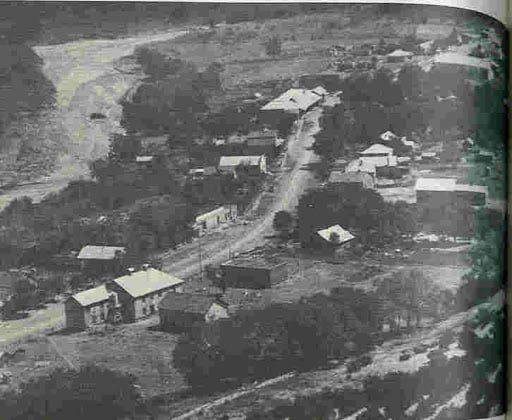
Only Billy and three others survived the battle. McCarty would try to cooperate with law enforcement afterward in hopes of clemency, but when he didn’t get it, he escaped, killing a deputy to do so.
He spent the last three years of his life on the run before being shot and killed by Pat Garrett, the Lincoln County Sheriff.
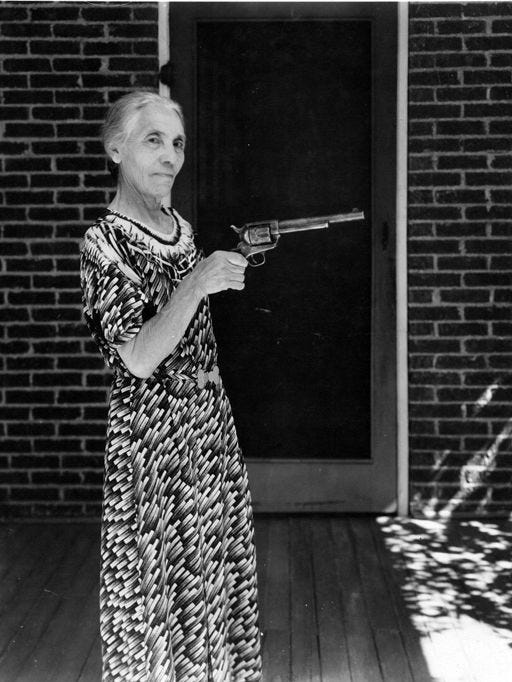
Billy the Kid was known to have owned a few different firearms.
His most prized was a Winchester Model 1873 (noticing a pattern?) with a 20-inch barrel. Billy’s preferred weapon, however, was a Colt M1877 Thunderer, something he may have shared in common with Doc Holliday.
However, Billy is known to have stolen a number of firearms throughout his criminal history, particularly when he escaped prisons, so he certainly owned a number of other guns throughout his life.
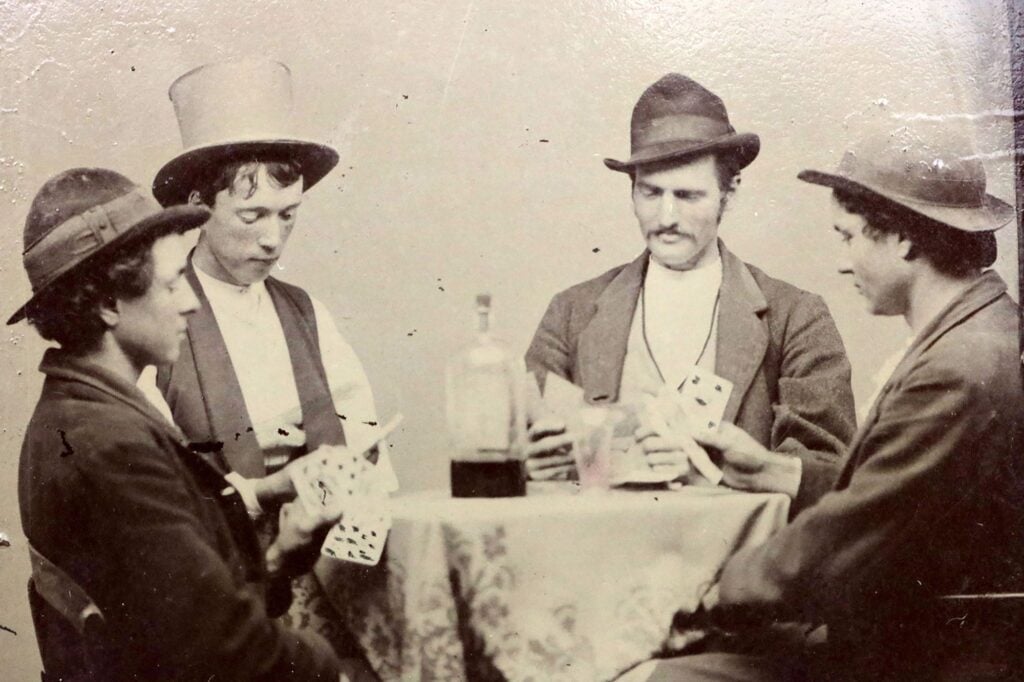
5. Butch Cassidy
Let’s wrap things up by talking about Robert LeRoy Parker, more commonly known as Butch Cassidy.
There’s not much to say about Cassidy’s early life. He was born in 1866 and grew up in a Mormon family in the Utah Territory, but ran away from home when he was still a young teen.
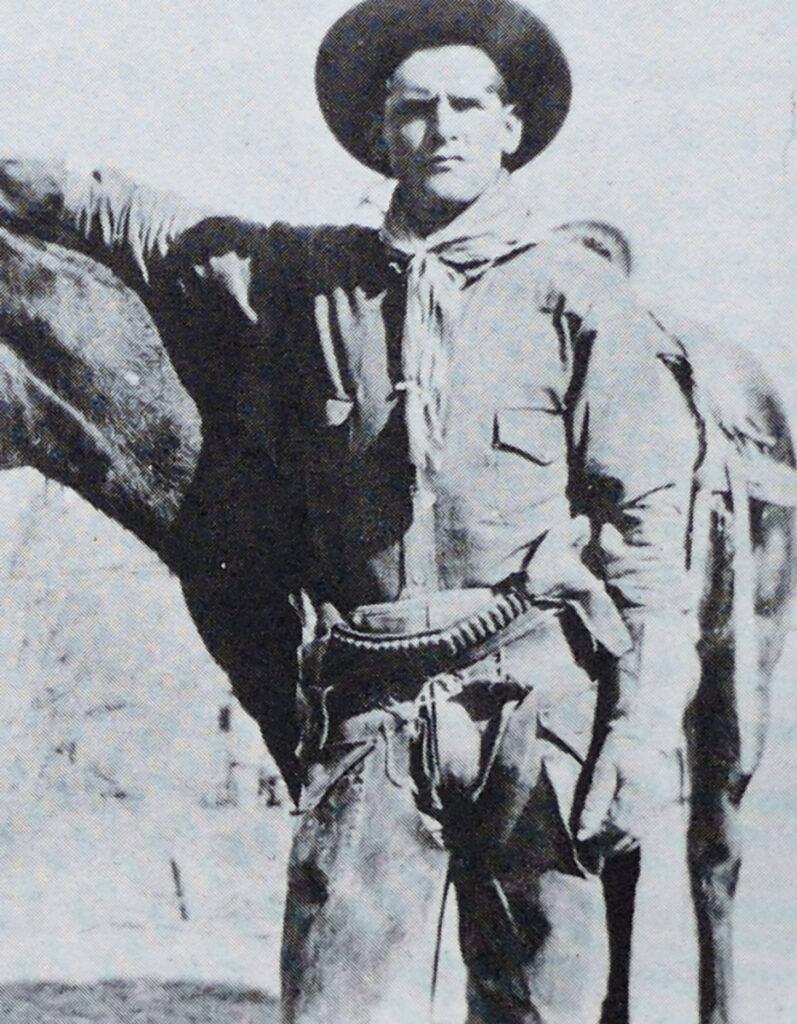
Shortly after, he met and befriended a cattle thief by the name of Mike Cassidy.
Around the same time, he took work at various cattle ranches and worked as a butcher’s apprentice.
The apprenticeship is where the first half of the nickname came from, with “Butcher” being shortened to “Butch.” The second, obviously, comes from Mike Cassidy’s name.
For years, Butch seemed to work pretty honestly, though he certainly looked up to Mike Cassidy and may have been involved in horse and cattle theft.
In 1889, however, he went big time when he, along with three other men, robbed the San Miguel Valley Bank in Telluride, Colorado. They made off with $20,000, equivalent to over half a million today.
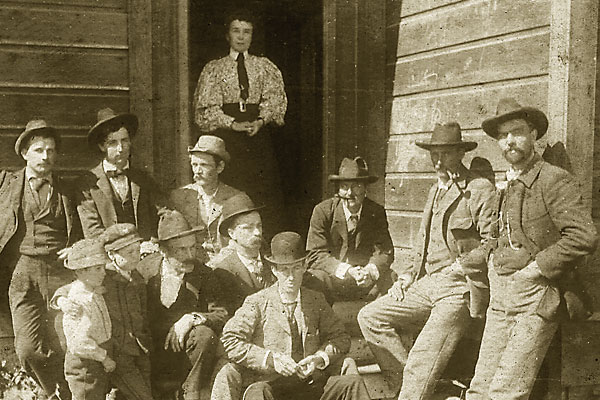
Go big or go home, I guess.
Anyway, after this robbery, Butch purchased a ranch outside of Dubois, Wyoming, though it seems like it was most likely used as a front for more illegal activities, like horse and cattle theft as well as protection racketeering, rather than actual ranching.
In 1894, however, Butch would be caught and jailed for 18 months.
After his release, Butch and several of his less-than-law-abiding friends would form the outlaw gang, the “Wild Bunch.” In the years that followed, the Wild Bunch robbed several trains as well as a bank or two.
While they certainly attracted the attention of both law enforcement and railroad companies, who resorted to hiring the Pinkertons to pursue the outlaws, they managed to successfully evade law enforcement each time.
All of that came to an end in 1900 and 1901, though, as members of the gang were killed or arrested by law enforcement one after the other.
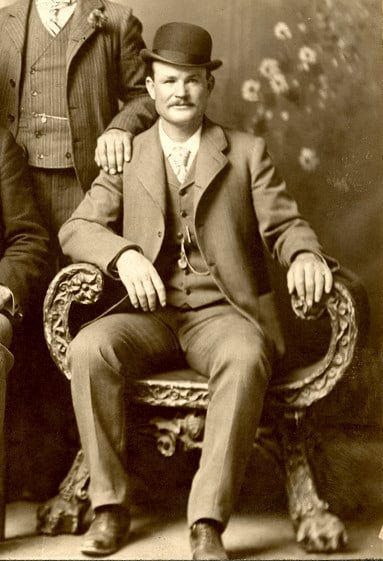
To avoid the same fate, Butch Cassidy, along with fellow Wild Bunch member Harry Longabaugh, AKA “the Sundance Kid,” escaped via steamship to Buenos Aires.
There they continued their robbery for several years throughout the southern area of South America. Eventually, this caught up to them in San Vincente, a small town in southern Bolivia.
Local authorities approached the boarding house where the two men were staying. The outlaws began shooting and the lawmen shot back.
Eventually, a man was heard screaming inside the house, two shots were fired from within, and everything was over.
Upon entry into the boarding house, they found two bodies, each with several bullet wounds on their bodies. Longabaugh also had a bullet wound on his forehead, while Cassidy had one to the temple.
It’s believed that Longabaugh had been fatally wounded by one of the policemen’s gunshots, so Cassidy shot him to end his suffering. He then killed himself rather than being captured.
For a man with Cassidy’s criminal history, you’d expect him to have owned and used several firearms. However, Cassidy seemed to favor just one: a .45-caliber Colt Single Action Army Revolver.
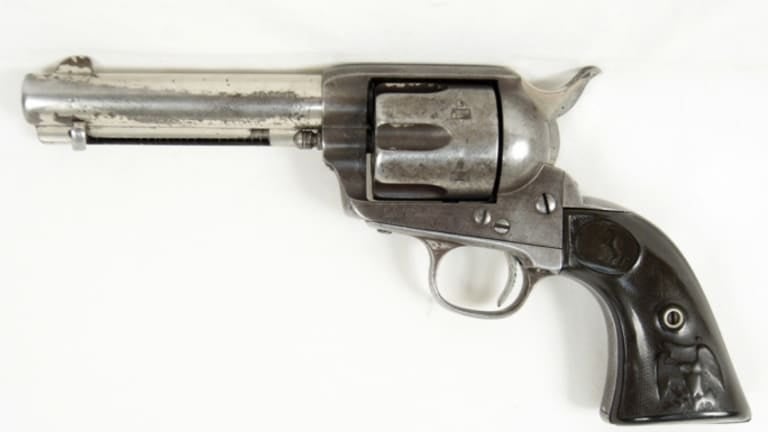
Cassidy obtained the revolver around the same time he started the Wild Bunch, but he surrendered it, along with a Winchester rifle, to Sheriff Parley P. Christison around early 1900 as part of an attempt to gain amnesty.
Obviously, that didn’t work out, but it did allow us to keep track of the so-called “amnesty Colt” over the years. In fact, it sold at auction for $175,000 in 2018.
The Colt has a series of numbers engraved on the inside of the right grip. If theorists are to be believed, these numbers are the combination to a safe that holds at least part of Cassidy’s stolen fortune. In reality, no one knows what the numbers mean, but what’s more fun than mysteries and hidden treasures?
Parting Shots
And that, sadly, brings us to a close on famous Western shooters.
Of course, this is hardly an exhaustive list and I’d have loved to have been able to include others like Calamity Jane, Wild Bill, the Earps, Jesse James, John Wesley Hardin, Jim “Killer” Miller, and more.
Unfortunately, I have to make myself stop somewhere. This is a website, after all, not a book and I have a tendency to push my editor when it comes to word counts as it is.
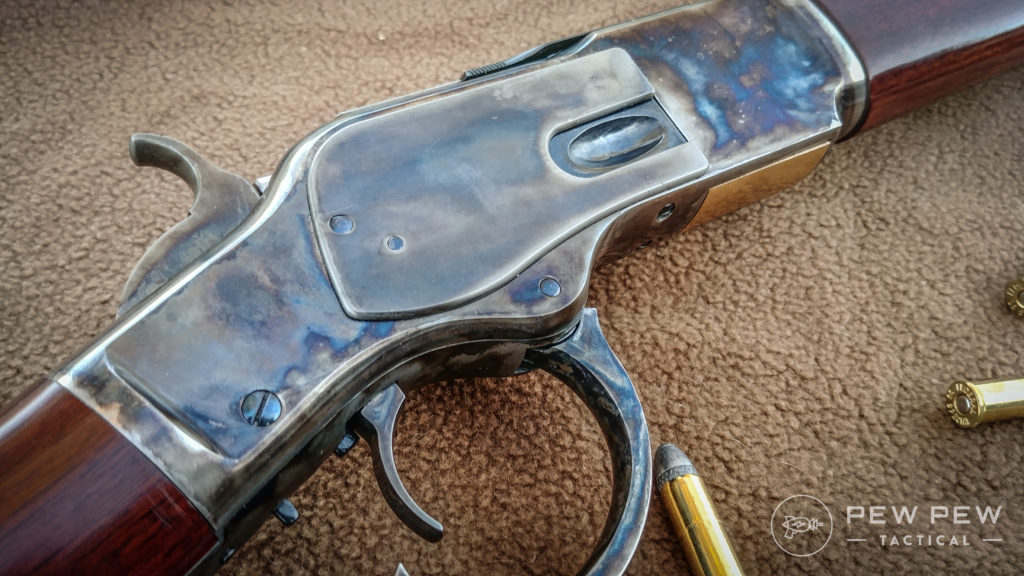
So instead, you tell me about your favorite Old West shooters in the comments. Why do you like them so much? Do you know what guns they carried? Tell me all about it! And for more Old West firearms history, check out our list of the Most Iconic Guns of the Old West.

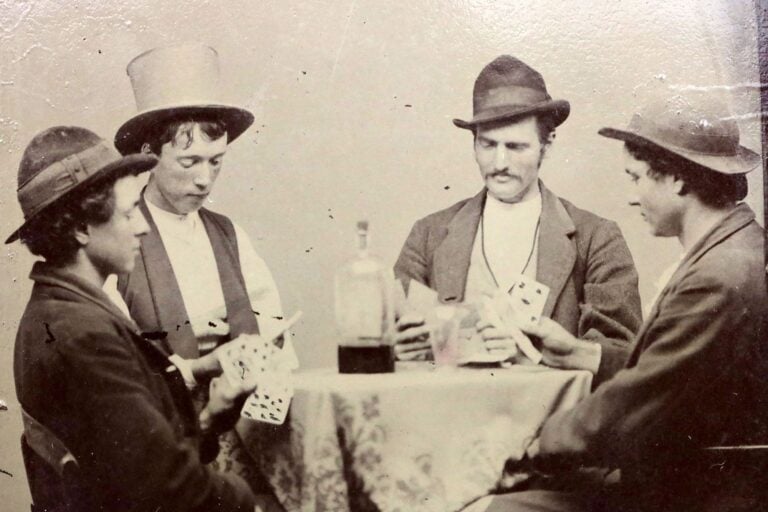







22 Leave a Reply
I’ve been playing Red Dead Redemption 2 and these stories were amazing, thank you.
Very cool article! I grew up on Clint Eastwood and John Wayne. This article was very fun to read and would like to see more like it!
I'm surprised there weren't a ton of comments to this. I grew up on Westerns and have subjected my wife and children to that love to the point where they have their own favorites as well. :D
Great article, and being a Southerner I definitely approve of Doc Holiday being on the list. Nice to see the Earps at least made "honorable mention". (My youngest son's name is Wyatt...take a guess at the inspiration for that). lol
Would love to see a follow on to this article that maybe talks to some of the myths or legends that grew around these figures or maybe what is it about the West and Single Action Guns that still has us fascinated with them to this day (I keep twin Vaqueros and a Henry Rifle for my Cowboy shooting days).
Fun read! Thanks again for posting it!
I have to correct something, the $20,000 that Butch Cassidy and company stole was not worth remotely close to $565 million. Inflation adjusted 1889 dollars is around 20:1 compared to today. So that $20,000 is the equivalent of around $4 million today. Not $565 million. median earnings per year in the US according to the 1890 census was $445. So the $20,000 represents about 45x the average annual earnings.
Would you mind screen capping where you're seeing the article say $565 mil? This was an error that we fixed on the same day that the article was published but people seem to still be seeing it. I can't find a second occurrence of it in the article so I'm wondering if we're having a weird error display the old version of the article or something.
thank you!
Good Morning,
As for the problem with the editing? It's still showing "half million today". I just snapped a screen capture.... my email will be entered below. How do I send the screen capture to you?
BTW, I loved the article! I'm from the south and also appreciate the mention of Doc! My husband shoots in competitions in the "Cowboy Fast Draw Association", our local club is having a competition this weekend honoring Doc Holliday! "CFDA, Hickory Flat Shootist Society" shoot is in Canton, Ga. They have a Facebook pages for the "CFDA" and our local club if you are interested in taking a look.
Thanks again for mentioning Georgia's native son!
David no longer works with PPT, but you're welcome to send it to my email -- jacki@pewpewtactical.com.
My favorite Old West shooter is one that has some connection to my own family, and that is Bartholomew "Bat" Masterson. My grandfather worked as a Pinkerton agent for years in the mid 1880's to the turn of the century in what was then the Oklahoma Territory. My father related several stories of his father coming in contact with some soon to be famous lawmen in pursuit of equally famous outlaws who preferred to live in the Territory rather than be seen in the cities of the time. One name that stands out to my father was Bat Masterson. His father would relate stories of Bat assisting in the capture of cattle rustlers, horse thieves, and a few bank robbers that had taken refuge in the wild and untamed lawless Oklahoma Territory.
The most notable weapon Bat Masterson owned that my grandfather knew about was a 2 shot, 38 caliber, pearl handled derringer, with which he was extremely accurate with. Dad told of an incident that proved that in a card game, when Bat caught a man cheating and shot him.
Adolf and Pinky Toepperwein shot for Winchester
Fun read, a little longer than expected, but I'm not complaining.
Did John Wesley Hardin perfect the "border shift" technique? In the border shift, you draw the strong side gun, empty it, toss the now empty gun in the air as you draw the weak side gun and pass that to the strong hand, and catch the empty gun with your weak hand and holster it, while continuing to fire with the strong side gun. I think the "border" part comes from the technique being used in El Paso.
Don't know about the border shift but Hardin was certainly a gunfighter! Interesting article.
Great bit of research. Enjoyed reading on these 5 shooters. This link include a photo of Wyatt Earp's S & W on display at the Red Dog Saloon in Juneau, Alaska. Reportedly he used it, and not a Colt, during the shoot out at the OK Corral. http://www.americancowboychronicles.com/2014/04/wyatt-earps-alaska-smith-wesson-model-3.html
Fun read. Thanks.
Awesome article and very interesting. The lives of those old time gun-slingers is certainly intriguing. My son just moved to Arizona to start a new job and he's been exploring some of the old western towns like Tombstone...
Great Article! Keep them coming. Check out Bass Reeves also.
Cool article, thanks for writing this! One point though - $20,000 in 1889 would be worth about $565,000 today, not $565 million.
Unless Doc Holiday was very, very old. And Wyatt Earp had a hot tube, time machine, in Dodge City. Then you made a typo error of the date they met up? (1978). LOL
But still a very enjoyable read. Thank you!
Fantastic piece of history, thanks for it man!!! ;-)
Good article. Two points. Your off by a factor of 1000 on the equivalent value of $20K in 1898. It's not $565M but $565,000.
I may be wrong on the following but I though the colt m1877 was a double action revolver.
$565,000 not $565,000,000. I first thought, why would he ever rob another bank. Great stuff, thank you for the content.
Oops, fixed! Thanks.
Out standing History Lesson!!